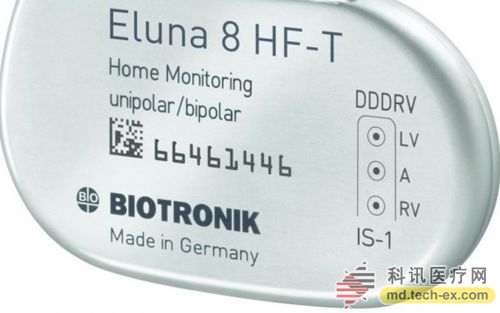Release date: 2015-07-01

With a genetic technology developed by Israeli researchers, heart patients may no longer need a pacemaker to keep the heart beating. Instead, they use a light-sensitive gene injected into the heart to replace the electronic device, using a blue beam to pace the heart.
The new cardiac pacing and cardiac resynchronization treatment technology was developed by Dr. Leo Gpstein and Dr. Judy Nusinovic of the Rappaport School of Pharmacy at the Israel Institute of Technology and Rambam Medical Center. The results of one of the studies in this technology were published this month in the journal Nature Biotechnology.
Cardiac pacemakers have undoubtedly saved many lives, but the device is not without risk. About 3 million people have pacemakers, and most people will die if they don't have pacemakers. The instrument monitors the natural beating of the heart by an electrical signal sent by the electrodes when stimulating the heart. If no heartbeat is detected within a certain period of time, the instrument will “wake up†the heart with a small low-voltage pulse current. In addition to simple heartbeat detection, recording of body temperature and adrenaline levels, more advanced equipment also allows the heartbeat to reach intensity during strenuous exercise.
But pacemakers are not a perfect solution. Problems associated with pacemakers include: infection, instrument malfunction, and shifting. With the new technology, users can completely eliminate the need for a pacemaker or implant surgery.
“The technology we developed is the first technology that enables heart-synchronized therapy without the need for electrical current,†says Gupstein. “There have been many advanced gene therapies and cell therapies that have produced bio-pacemakers, only from One position pacing the heart. But these methods cannot simultaneously resynchronize treatment from multiple locations, activating the heart."
The study of light-stimulated genes has been carried out for several years and belongs to the field of photogenetics. In this discipline, light is used to control neurons that are sensitive to light. Most of the use of this method is still in the experimental stage, but it shows a broad application prospect. For example, in a study, the auditory function of a mouse was restored after stimulation of the spine of a deaf mouse by photogene stimulation. Researchers in the field continue to extract light-sensitive genes from algae and introduce them into other cells to act as switches that cause cells to make or stop specific behavior when stimulated by light pulses.
Mice were experimented with technology at the Technion and Rambam Medical Center. The researchers injected one of the algal genes (photosensitive channel protein-2) into a specific region of the mouse myocardium. Subsequently, the scientists discovered that the light-sensitive protein expressed in this region can be activated by a blue light beam to stimulate the heart to contract. By changing the frequency of the beam, Gpstein and Nusinovic can control and regulate heart rate. They continue to introduce the gene into several regions of the heart chamber and find that the gene can activate the heart from multiple locations at the same time, solving the problem of ventricular systolic dyssynchrony when the heart beats.
Gupstein said that scientists still need to do more research around this photogenetic-based cardiac pacing technology in order to turn the technology into reality for the benefit of human health. For example, genes injected in mouse experiments are sensitive to blue light, but difficult to penetrate tissue, which may limit its role in large animals or humans.
"This means that the cells into which the gene is introduced must have a relatively thin cell membrane that is close to the thickness of the epicardium, and the optical fiber that carries the beam should be implanted as close as possible to those cells," Gupstein said. "A possible solution in the future is to develop a similar light-sensitive protein that responds to light in near-infrared or even far-infrared spectroscopy and can penetrate tissue more easily and receive long-distance illumination."
Jeffrey, Director of Cardiology and Co-Director of the Cardiovascular Center at the University of California, San Francisco? Dr. Okin said: "This is a very important proof-of-concept experiment, showing for the first time the mechanism of pacing the heart through multiple locations without the need for wires."
“The most common cause of heart pacemakers currently in use is the leads or wires that connect the myocardium and current pulses. The method described in this paper may no longer require the use of these wires or stimulate multiple locations simultaneously through a single lead catheter. ."
Source: Israel Times
Black beans are rich in protein, fat, carbohydrates, carotene, vitamins B1, B2, crude fiber, calcium, phosphorus, iron and other nutrients, and contain a small amount of daidzein glycoside genistein. Can cure disease, medicine and food are salty. Traditional Chinese medicine believes that black beans are a cheap and anti-aging food, with special functions of medicine and food.
Jilin Yomi Agricultural and Sideline Products Import and Export Co.LTD. focusing on building a green base, building a characteristic industrial chain, deepening the channel supply chain, vigorously developing export trade, and leading the development direction of the entire industry; insisting on green development, promoting the concept of health, and making every effort to build a national leading enterprise in the organic grain industry.
Black Bean,Black Bean Nutrition,Black Bean Rice,Organic Black Beans
Jilin Yomi Agricultural Products Co.LTD , https://www.yomifresh.com
